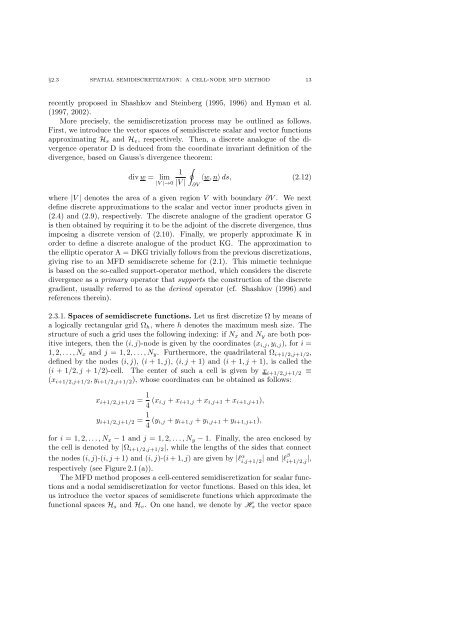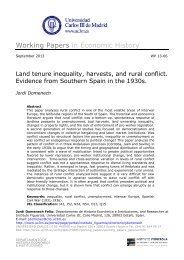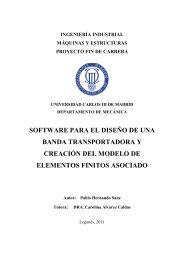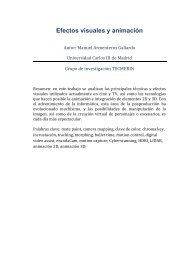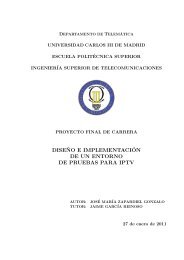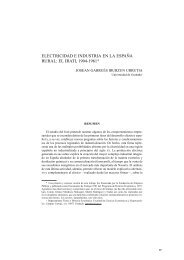Métodos miméticos de pasos fraccionarios - E-Archivo - Universidad ...
Métodos miméticos de pasos fraccionarios - E-Archivo - Universidad ...
Métodos miméticos de pasos fraccionarios - E-Archivo - Universidad ...
You also want an ePaper? Increase the reach of your titles
YUMPU automatically turns print PDFs into web optimized ePapers that Google loves.
§2.3 spatial semidiscretization: a cell-no<strong>de</strong> mfd method 13<br />
recently proposed in Shashkov and Steinberg (1995, 1996) and Hyman et al.<br />
(1997, 2002).<br />
More precisely, the semidiscretization process may be outlined as follows.<br />
First, we introduce the vector spaces of semidiscrete scalar and vector functions<br />
approximating Hs and Hv, respectively. Then, a discrete analogue of the divergence<br />
operator D is <strong>de</strong>duced from the coordinate invariant <strong>de</strong>finition of the<br />
divergence, based on Gauss’s divergence theorem:<br />
div w = lim<br />
|V |→0<br />
1<br />
|V |<br />
<br />
∂V<br />
⟨w, n⟩ ds, (2.12)<br />
where |V | <strong>de</strong>notes the area of a given region V with boundary ∂V . We next<br />
<strong>de</strong>fine discrete approximations to the scalar and vector inner products given in<br />
(2.4) and (2.9), respectively. The discrete analogue of the gradient operator G<br />
is then obtained by requiring it to be the adjoint of the discrete divergence, thus<br />
imposing a discrete version of (2.10). Finally, we properly approximate K in<br />
or<strong>de</strong>r to <strong>de</strong>fine a discrete analogue of the product KG. The approximation to<br />
the elliptic operator A = DKG trivially follows from the previous discretizations,<br />
giving rise to an MFD semidiscrete scheme for (2.1). This mimetic technique<br />
is based on the so-called support-operator method, which consi<strong>de</strong>rs the discrete<br />
divergence as a primary operator that supports the construction of the discrete<br />
gradient, usually referred to as the <strong>de</strong>rived operator (cf. Shashkov (1996) and<br />
references therein).<br />
2.3.1. Spaces of semidiscrete functions. Let us first discretize Ω by means of<br />
a logically rectangular grid Ωh, where h <strong>de</strong>notes the maximum mesh size. The<br />
structure of such a grid uses the following in<strong>de</strong>xing: if Nx and Ny are both positive<br />
integers, then the (i, j)-no<strong>de</strong> is given by the coordinates (xi,j, yi,j), for i =<br />
1, 2, . . . , Nx and j = 1, 2, . . . , Ny. Furthermore, the quadrilateral Ω i+1/2,j+1/2,<br />
<strong>de</strong>fined by the no<strong>de</strong>s (i, j), (i + 1, j), (i, j + 1) and (i + 1, j + 1), is called the<br />
(i + 1/2, j + 1/2)-cell. The center of such a cell is given by x i+1/2,j+1/2 ≡<br />
(x i+1/2,j+1/2, y i+1/2,j+1/2), whose coordinates can be obtained as follows:<br />
x i+1/2,j+1/2 = 1<br />
4 (xi,j + xi+1,j + xi,j+1 + xi+1,j+1),<br />
y i+1/2,j+1/2 = 1<br />
4 (yi,j + yi+1,j + yi,j+1 + yi+1,j+1),<br />
for i = 1, 2, . . . , Nx − 1 and j = 1, 2, . . . , Ny − 1. Finally, the area enclosed by<br />
the cell is <strong>de</strong>noted by |Ωi+1/2,j+1/2|, while the lengths of the si<strong>de</strong>s that connect<br />
the no<strong>de</strong>s (i, j)-(i, j + 1) and (i, j)-(i + 1, j) are given by |ℓα i,j+1/2 | and |ℓβ i+1/2,j |,<br />
respectively (see Figure 2.1 (a)).<br />
The MFD method proposes a cell-centered semidiscretization for scalar functions<br />
and a nodal semidiscretization for vector functions. Based on this i<strong>de</strong>a, let<br />
us introduce the vector spaces of semidiscrete functions which approximate the<br />
functional spaces Hs and Hv. On one hand, we <strong>de</strong>note by Hs the vector space


